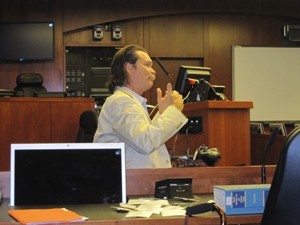From Jim Comstock-Galagan
The recent amendments to Section 504 and the ADAA greatly expanded coverage under Section 504/ADA. The ADA Amendments Act, Public Law No. 110–325 (2008), overturned Supreme Court precedent that narrowed coverage under the ADA and Section 504.
The reauthorized law provided that impairments should be considered in their unmitigated state and widened the definition of major life activities set out in the statute’s coverage provision.
There are ways to use Section 504 and the Americans with Disabilities Amendments Act of 2008 (ADAAA). Read A New Look at Section 504 and the ADA in Special Education Cases by Mark C. Weber.
http://apps.americanbar.org/litigation/committees/childrights/content/articles/summer2011-section-504-ada-idea.html
In that article, Professor Weber wrote,
“School districts seem increasingly eager to decide that children are not eligible for services under the Individuals with Disabilities Education Act (IDEA) …and courts frequently uphold these decisions…”
“If eligibility under IDEA continues to be cut back, parents of children with disabilities are likely to bring more claims for services under section 504 of the Rehabilitation Act of 1973, 29 U.S.C.A. § 794 (2011), and Title II of the Americans with Disabilities Act (ADA), 42 U.S.C.A. §§ 12131–50 (2011).
“Section 504 forbids disability discrimination by federal grantees, including local school districts; Title II forbids disability discrimination by state and local governments, again including school districts. The regulations promulgated to enforce section 504 require that all children with disabilities, as defined by section 504 and the ADA, be provided with free, appropriate public education as interpreted by the section 504 regulations. (34 C.F.R. § 104.33(a)). That entitlement does not hinge on IDEA eligibility.”
Jim notes that historically, Section 504 has been used to supplement IDEA for compensatory damages, but there has been very little litigation under Section 504 in other areas.
The ADAAA expanded the definition of which children and adults qualify for protections. For example, a child who has ADHD but is doing well in school because his medication is working.
FAPE Under Section 504
The definition of “free appropriate public education” is different under Section 504 than under IDEA.
The question that must be asked and answered is this: “Are the needs of the disabled child or children being met as adequately as the needs of nondisabled children?”
Jim says, “I believe FAPE under 504 goes further than FAPE under IDEA.” He uses the example of graduation rates.
“Assume the overall graduation rate in your State is 72%, but the graduation rate of kids with disabilities who are not intellectually disabled is 52%. So, twenty percent fewer kids with disabilities graduate with a high school diploma. Are the needs of disabled children being met as adequately as the needs of nondisabled children? If they are not, aren’t these children being discriminated against as a result of their disabilities?”
“This is a powerful argument that is not available under IDEA.”
“Perhaps we’ve been so focused on meeting the individualized needs of kids with disabilities that we may be missing the forest for the trees.”
504 & Discipline
Jim explained, “I specialize in discipline issues in my practice. I recommend that you read an expulsion case from 1981 – S-1 v. Turlington, 635 F.2d 342.
http://openjurist.org/635/f2d/342/s-1-p-1-v-d-turlington
Expulsion is a change of placement. If the child’s behavior is related to disability, the school cannot suspend the child or terminate services.
Kids are often assigned to alternative schools for 45 days or longer. Under IDEA, kids are subject to long-term suspensions for weapons, drugs, and seriously bodily injury, but many kids are placed in alternative schools for relatively minor issues. Long-term suspensions (beyond 10 days) are a change in placement.
S-1 v. Turlington says schools cannot change the child’s placement under these circumstances. It’s time to revisit S-1 v. Turlington.
Disparate Impact and Disproportionate Treatment
In discussing intentional or unintentional discrimination, Jim describes a recent complaint filed with OCR that was based on title VI and Section 504/ADAAA. The complaint focused on dramatically different discipline rates and referral rates to alternate schools.
Restraint and Seclusion
504 opens up other issues, including restraint and seclusion.
Jim asks, “How many school districts in your state have policies on restraint and seclusion? How many school districts in your state have restraint and seclusion policies for nondisabled kids?
“None?”
“Restraint and seclusion policies only apply to kids with disabilities. Shouldn’t these policies apply to all kids?”
“If I’m a 504 kid, I’m entitled to a free appropriate public education as it is defined under Section 504. Since restraint and seclusion policies only apply to kids with disabilities, I want to be treated as a nondisabled kid.”
“The key is equal treatment. If a school uses restraint and seclusion, this has to apply to everyone.”
On May 15, 2012, the U. S. Department of Education issued a “Resource Document” that discourages schools from using restraint and seclusion.
“The Resource Document includes 15 principles that highlight how school behavioral interventions can educe or eliminate the use of restraint or seclusion. These principles offer states, districts and other education leaders a framework for developing appropriate policies related to restraint and seclusion to ensure the safety of adults and children.
The Secretary of Education, Arne Duncan said, “Ultimately, the standard for educators should be the same standard that parents use for their own children. There is a difference between a brief time out in the corner of a classroom to help a child calm down and locking a child in an isolated room for hours. This really comes down to common sense.”
News release: http://www.ed.gov/news/press-releases/us-department-education-issues-resource-document-discourages-restraint-and-seclu
Link to Restraint & Seclusion: Resource Document
http://www2.ed.gov/policy/seclusion/restraints-and-seclusion-resources.pdf

Jim Comstock-Galagan is the Executive Director of the Southern Disability Law Center (SDLC), New Orleans, LA and a faculty member at W&M Law School Institute of Special Education Advocacy (ISEA).





Hoping this is a reasonable place to post this.
My 5 year old with high functioning autism has a 504 Plan in Georgia(school thought he was too advanced for an IEP). One of the things written in the 504 plan is for a smaller class size. We interpreted that to mean he should be in the inclusion class in his new school (entering 1st grade). New school says they want to take that line out of the 504 Plan, and ONLY IEP students are allowed in the inclusion classes. Do we have any ground to stand on to push for him to be in the inclusion class?
I believe they could do this, but state accounting rules would probably require them to use some non-special ed funds to fund the class. The state dept. of ed could answer that for you and them.
I cant find an appropriate place to post this Q. My kid is in private preschool so ADA applies. HOW LONG can school take to develop BIP related to his disability? Hes been suspended for 13 days now waiting for it.
he has serious speech delays and is hearing impaired with bilateral hearing aids.
There is no federal rule on this that I am aware of. The federal Office of Civil Rights enforces the ADA. Your state parent training, and information center may be able to assist you. http://www.parentcenterhub.org/find-your-center
My grandson is autistic and non-verbal. The School System in Kentucky has not provided FAPE. He is currently in the 4th Grade and academically performing at a second grade level. They have not provided a sign language interpreter and have not provided sign language instruction by a certified sign language teacher for four years. I need an attorney to handle this case in Kentucky. Do you know of a special education attorney that can assist us?
Vicki: Try searching for an attorney/advocate in your area in the listings below.
http://www.yellowpagesforkids.com/help/ky.htm
http://www.copaa.org/search/custom.asp?id=643
http://www.education-a-must.com/advocates.html
The National Disability Rights Network previously maintained an attorney directory. This directory is no longer available, but you may want to contact the agency in your area for information and/or recommendations.
http://www.ndrn.org/en/ndrn-member-agencies/kentucky.html
My sons school has been out of compliance with his 504 plan all year and we have had 2 meeting to try to resolve this. While many things have been fixed, there are still some things out of compliance. I didn’t want to have to file a child complaint because we are at the end of the year and I was hoping that we could start the year off with a new teacher and no problems. I have since learned that his teacher has gone to the next grade level teachers and told them about the problems they are going to have with my son. He has now been labeled with those teachers and they are expecting a “bad kid” My son has a 504 because he has severe asthma and allergies not because of behavior. How should I handle this situation?
Karen, It sounds like the school is taking away a needed accommodation that allows your son to learn. That is discrimination since the other students have the means to learn. 504 deals with discrimination so you may have a case however you may have to enlist help from your local Civil Rights Office and/or an attorney to get something to happen quickly. The other option is to request an evaluation to see if your son qualifies for services under the IDEA law & could receive those accommodations on an IEP. Your local autism support group would be a great place to start.
I asked for a sign language tutor for my son who is non-verbal but is not hearing impaired. He is diagnosed with fragile x syndrome, and autism. He has made remarkable gains with a sign language tutor that was in his class room this year, but won’t be there next year.
The principal says we would never qualify for that type of service for him.
I believe my son has a right to learning to communicate as much as a child with a hearing impairment.
How do I proceed?